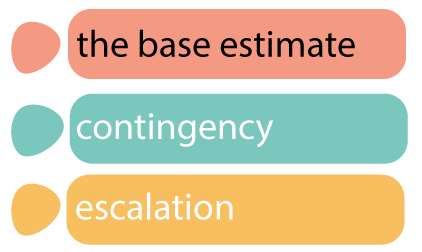This Toolkit item relates to Part 1 - Investment Proposal & Business Case Development in the Commonwealth Investments Resource Management Guide.
What is cost estimation?
Cost estimation is the process of approximating the cost of a policy, program or project and is important in establishing the basis for key spending and investment decisions. Following best practice principles for cost estimation help ensure the efficient use of public resources and minimise the risk of cost overruns.
For investment proposals there is typically a source of revenue that can be capitalised therefore facilitating the use of an investment or financing instrument. Testing the veracity of the assumptions underpinning revenue projections is equally as important as the strength of the cost estimation process.
General costing principles
There are 3 components of a capital cost estimate for a major project:

The base estimate
The Base Estimate is the best assessment of the quantities and rates associated with a given scope of work according to a defined estimating practice or policy. The Base Estimate consists of 2 components – Construction Costs and Client Costs.
Construction costs refer to costs required to complete the tasks or activities associated with the construction elements of a project. Typically construction costs are the costs paid to the external construction contractor, and comprise both direct costs and indirect costs.
- Examples of direct construction costs include the estimated cost of labour, plant, materials and specialist subcontract work required to deliver the asset.
- Examples of indirect construction costs include project insurances, site management and supervision.
Client costs are incurred by the project proponent to develop and deliver a project. They include client staff costs, project management and design costs that are not incurred by the construction contractor.
Contingency
Contingency refers to the component of a project’s cost (in excess of the base estimate) that accounts for, or reflects, the level of residual risk the project proponent is prepared to bear. The uncertainty inherent in all estimates and estimating processes mean that it is best represented as a range. Generally, the earlier on in the project development, the higher the contingency.
Methods for establishing contingency are generally divided into 2 groups: probabilistic methods and deterministic methods. Probabilistic cost estimation process should be followed for all projects where possible as it leads to a more accurate cost estimate when undertaken correctly.
Probabilistic methods involve the use of complex mathematical models to generate a large sample of possible project cost estimates and the frequency of occurrence of each. Each possible estimate of the total project cost can be given a probability or “P-value” which reflects the likelihood of that value not being exceeded.
The figure above shows the output generated after modelling a large sample of possible project outcomes for a particular project. The inclusion of the S-shaped curve allows for any P-value to be directly read off the chart. The P90 cost for this particular project is $99.70.
In recognition of the complexity or probabilistic methods, for low value projects, a deterministic method may be more appropriate. A probabilistic cost estimation process must be used for all projects, for which Australian Government funding is sought, with a total anticipated outturn cost (including contingency) exceeding $25 million. A deterministic methodology to estimate contingency may be used for projects under that threshold. A factor-based deterministic approach calculates a single overall range of contingency allowance. The rationale behind a factor based approach is that it attempts to properly identify those items that can have a critical effect on the project outcomes and applies ranges only to those items
Escalation
Escalation refers to the changes in costs for the period from the base date of the estimate (the date at which the rates for cost elements were current) to a future time period (usually the completion of construction). Costs change over time due to changes in technical, economic and market conditions. It is important to find methods to quantify and manage cost escalation to ensure there are sufficient funds to deliver the investment within budget and on schedule.
An escalation allowance is applied to the project cash flow (the sum of the base estimate and contingency allowance in the financial years in which the expenditure will occur) in recognition of such changes. In simple terms, escalation is adding a cost increase to each year of a profile to bring it into nominal dollars.
Other costs
When developing a business case for a project, in addition to capital costs, it is important to factor in the whole-of-life costs for the asset once in service. Whilst a component of the operating costs include asset function costs (for example, cost of repairs and maintenance, facilities management etc.) the cost of managing the asset as well as financing and administration costs need to be considered as well.
Refer to the business case development for further guidance.


